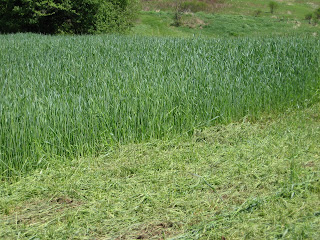Friday, October 31, 2008
Thursday, October 30, 2008
Cooler days perfect for planting garlic
I Passed!
 It is official! I am an OSU Master Gardener!
It is official! I am an OSU Master Gardener!
"Hi Amy: You scored 83 out of 100, and then 4 bonus points, for a total score of 87! Welcome to the Franklin County Master Gardener program. I'd like to talk with you about your interests, how we can plug you into existing projects and initiatives, and how we can tap your ideas and creativity for new projects and initiatives. If you have any interest in teaching, we have our Home Gardener Series coming up January through April.
Hope to talk with you soon.Thanks!
Cory"
Wednesday, October 29, 2008
TUESDAY NOVEMBER 11TH
 "An Evening with Dr. Antonia Demas"
"An Evening with Dr. Antonia Demas"
Tuesday, November 11th, 2008
Indianola Alternative School, 100 West 4th Avenue, Columbus 43201
Reception & Food Tasting from 6:30-7pm
Keynote Speaker: Dr.Antonia Demas 7-8:30pm
Sponsored by The Greener Grocer and Two Caterers
Local Matters, a nonprofit organization that plays a leadership role in providing equal access to healthy, locally grown food for everyone in our community, invites you to join Dr. Antonia Demas for a special evening of discussion about the importance of healthy, nutritious food in each of our lives and especially its effects and benefits for our children.
Dr. Demas has taught food studies in a variety of educational settings to people of diverse ages, ethnicities, and economic backgrounds all of her life. After graduating from Godard College with a B.A. in Community Nutrition, she worked for 20 years in food education before completing a Ph.D. at Cornell University.
Dr. Demas will begin speaking at 7pm and will talk about her book, "Food is Elementary", a hands-on, experiential food-based curriculum designed for teachers and trained food educators. This book contains 28 sequential (and 8 supplemental) lessons with age-appropriate lesson plans for pre-K through 2nd grade and 3rd grade through 8th grade, in addition to equipment lists and “how to” guidelines. Additionally, Dr. Demas will also answer questions from the audience in a town hall style format.
The evening will begin with a tasting of delicious, local foods, hosted by The Greener Grocer and their “green” catering partner, Two Caterers. The cooking teams will prepare several recipes from the "Food is Elementary Curriculum” and as our guest, you will have the opportunity to get to know each other and enjoy some of Ohio's best local products!
We encourage you to attend this evening and to join in this discussion about the role of food in our schools and it’s effects on our children’s health and performance. We also encourage you to invite other members of your community, including professionals in other fields, who could benefit from this conversation and help Local Matters promote our mission of equal access to healthy, nutritious food for everyone in our community.
Please call 614.263.5662 or email info@local-matters.org with any questions.
We look forward to seeing you!
Crazy Veggies
 I had posted an interesting image about a square watermelon when I was first getting going with this blog. I always thought it would be an interesting project, and then I found some other weird/crazy ideas from looking at my RSS feeds.
I had posted an interesting image about a square watermelon when I was first getting going with this blog. I always thought it would be an interesting project, and then I found some other weird/crazy ideas from looking at my RSS feeds.



 Who I accessed through Neatorama. http://www.neatorama.com/
Who I accessed through Neatorama. http://www.neatorama.com/Machine Tillers/Disrupting Soil/ETC!
I just read about a tiller that You Grow Girl was asked to review (read: review=free tiller). Must be nice to get things like tillers delivered to your door. She works hard for it, and has made herself a brand name, so good for her! How do I get this blog to take off like that?!
Anyway, there seems to be quite a bit of opinion concerning tillers, digging into the soil as opposed to amending it, etc. I guess I hadn't realized this was such an area of contention.
So far in my veggie garden career, I have used a tiller I borrowed from a neighbor in my garden (thanks, Kim!) in the spring and fall for the past two years. Without doing any scientific studies, I can tell you right now my soil is not the best.
*SIGH* I also added sand to my garden thinking that would be a good soil amendment, but that just makes concrete. This incredible garden maneuver should reveal to you how much I know and how I tend to learn.
Does the tiller have anything to do with my poor soil? I don't know. But I do really like this tool if you are going for the old-fashioned method: So, soil is my new focus. This my new area of growth as a gardener. And from all of my research, it would appear that now is the time to build it for spring. Will I till? Not this year. I would like to get my soil tested though. Put that on my to-do list!
So, soil is my new focus. This my new area of growth as a gardener. And from all of my research, it would appear that now is the time to build it for spring. Will I till? Not this year. I would like to get my soil tested though. Put that on my to-do list!
 Another great resource from the Ready Made Blog:
Another great resource from the Ready Made Blog:
Check out the community garden starter kit. So clever!
Youth Grants and Funding Opportunities!
Please check out these funding opportunities for youth, arts, education, nutrition, etc. Note that some are due very soon.
Bill
Youth Today’s Grants E-Blast
Week of Oct. 27, 2008
© 2008 Youth Today
Compiled by Erika Fitzpatrick
(Subscribers: Login to Youth Today Online to search and sort all available grants, including notices with rolling deadlines, which are not listed here.)
Featured Grant
*Grant: Arts Connect All – To encourage arts organizations to create or enhance multi-session, inclusive education programs for youth with disabilities by strengthening partnerships with local public schools.
Funder: VSA arts and MetLife Foundation.
Eligibility: Nonprofit performing and/or exhibiting arts organizations – such as museums, theaters and multidisciplinary arts presenters – that are creating or have an established educational program.
Deadline: Dec. 12.
Amount: Up to 10 awards of up to $15,000.
Contact: www.vsarts.org/x273.xml.
Advocacy
*Grant: 2009 National CASA Awards of Excellence – To recognize the work of child advocates, program directors, judges, board members and Court-Appointed Special Advocates/Guardians Ad Litem (CASA/GAL) programs excelling in diversity and inclusion efforts.
Funder: National CASA.
Eligibility: Nominations of outstanding judges, board members or volunteers in CASA/GAL programs are invited.
Deadline: Nov. 30.
Amount: Complimentary conference registration, travel and hotel expenses, as well as $1,500 toward honorees’ programs.
Contact: www.casanet.org/conference/excellence.htm.
Arts
Grant: NAMM Foundation Grants – Music education and research grants are available through programs that include the Disney Music in You Grant Program; Sounds of Learning: The Impact of Music Education; and Sounds of Living: The Impact of Music Across the Life Span.
Funder: NAMM Foundation.
Eligibility: Public middle and high schools, and music education and research programs.
Deadline: Disney Music in You – Dec. 15; all others, Dec. 1.
Amount: Grants average $20,000 to $40,000.
Contact: www.music-research.org/Grants/guidelines.html.
Grant: Media That Matters – A showcase for short films with big messages, including youth-produced projects.
Funder: Art Engine.
Eligibility: Individual filmmakers and community/youth media centers.
Deadline: Jan. 9, 2009.
Amount: $1,000 per film.
Contact: www.mediathatmattersfest.org/submit.
Child Welfare
Grant: Brookdale Relatives as Parents Program (RAPP) – To develop or expand services for grandparents and other relatives who have taken on the responsibility of surrogate parenting when the biological parents cannot.
Funder: Brookdale Foundation.
Eligibility: Nonprofits.
Deadline: Dec. 4.
Amount: Each of 30 selected organizations will receive a two-year mini-grant of $10,000.
Contact: www.brookdalefoundation.org/RAPPrfpdownloads.htm.
Civic Engagement
Grant: To promote understanding of environmental issues among youth.
Funder: Captain Planet Foundation.
Eligibility: Nonprofits.
Deadline: Dec. 31.
Amount: $250 to $2,500.
Contact: www.captainplanetfoundation.org/default.aspx?pid=3&tab=apply.
Grant: We the People Challenge Grants in U.S. History, Institutions and Culture – To support humanities activities that examine American history through the lens of the nation’s founding principles.
Funder: U.S. National Endowment for the Humanities.
Eligibility: States, special district and tribal governments, institutions of higher education and other nonprofits.
Deadline: Feb. 3, 2009.
Amount: Up to $1 million.
Contact: www.neh.gov/grants/guidelines/wtpchallenge.html#awardinfo.
Grant: Lexus Eco Challenge #2: Water Works – To encourage school environmental projects affecting local communities in the areas of water conservation, shrinking wetlands and habitats, and threats to oceans and waterways.
Funder: Scholastic, Inc.
Eligibility: Teams of elementary and high schools students and teacher advisers.
Deadline: Dec. 12.
Amount: 16 teams will receive $10,000 each.
Contact: www.scholastic.com/lexus/waterchallenge_welcome.asp#details.
Grant: AmeriCorps 2009 State and National Grants – To improve lives, strengthen communities and foster civic engagement through service and volunteering. Priorities in 2009 are mobilizing more volunteers, ensuring a brighter future for America’s youth, engaging students in communities, harnessing baby boomers’ experience, and helping communities recover from and prepare for disasters.
Funder: U.S. Corporation for National and Community Service.
Eligibility: Organizations that work in just one state apply through state commissions. Organizations that work in more than one state may apply for national grants. Indian Tribes may apply through state commissions, or directly to the corporation. (Check notice for complete eligibility rules.)
Deadline: Jan. 13, 2009.
Amount: Nearly $69 million is available under the various program categories.
Contact: www.nationalservice.gov/pdf/08_0531_nofa_ac.pdf.
Grant: Increase Your Green – For student-led projects to reduce the carbon footprint of schools.
Funder: Do Something.
Eligibility: Middle and high schoolers.
Deadline: The competition started Oct. 13; see website for details.
Amount: $1,500 for first prize and $500 for three second-place prizes.
Contact: www.dosomething.org/increase_your_green.
Grant: Lorrie Otto Seeds for Education (SFE) Fund – For schools and nature centers to plant and maintain natural landscapes.
Funder: Wild Ones.
Eligibility: Schools, nature centers and nonprofit places of learning, including houses of worship.
Deadline: Nov. 15.
Amount: $100 to $500.
Contact: www.for-wild.org/sfecvr.html.
Education
Grant: No School Left Behind Software – Awards of a perpetual license to VIP Tone’s School MATRIX software product, designed to enable educators to manage information on student standards, curriculum and progress.
Funder: VIP Tone.
Eligibility: Any public U.S. school district with total student enrollment of 1,000 or fewer students.
Deadline: Jan. 16, 2009.
Amount: The list price of the license is $18,000.
Contact: www.viptone.com/NSLB.htm.
Grant: Educator grants – To promote aerospace education activities in classrooms from kindergarten through grade 12.
Funder: Air Force Association.
Eligibility: Schools.
Deadline: Nov. 14.
Amount: Up to $250.
Contact: www.afa.org/aef/aid/educator.asp.
Grant: Love Your Veggies – To increase access to and consumption of fresh fruits and vegetables in elementary schools.
Funder: Hidden Valley Salad Dressings.
Eligibility: Elementary schools.
Deadline: Nov. 7.
Amount: 10 grants of $15,000 each.
Contact: www.loveyourveggiesgrants.org.
Grant: Surdna Arts Teachers Fellowships – To support the artistic revitalization of outstanding arts teachers in public arts high schools.
Funder: The Surdna Foundation.
Eligibility: All permanently assigned full- and part-time arts faculty in public arts high schools.
Deadline: Nov. 14.
Amount: 20 awards of up to $5,500 each, with a complementary grant of $1,500 to the fellow’s school to support post-fellowship activities.
Contact: www.surdna.org/resources/resources_show.htm?doc_id=697830.
Health
*Grant: Olympus Innovation Awards – For innovation in education.
Funder: National Collegiate Inventors and Innovators Alliance (NCIIA).
Eligibility: Faculty nominees from NCIIA member institutions.
Deadline: Nov. 21.
Amount: Winners receive awards ranging from $1,000 to $10,000.
Contact: www.nciia.org/olympus/index.html.
*Grant: Healthy Start Initiative – To eliminate racial and ethnic disparities in perinatal health indicators.
Funder: U.S. Health Resources and Services Administration.
Eligibility: Public and private nonprofits.
Deadline: Dec. 5.
Amount: Nearly $80 million for 74 awards.
Contact: http://www07.grants.gov/search/search.do?&mode=VIEW&flag2006=false&oppId=43140.
Grant: Coverage Ideas From the Field – For applicant-initiated projects related to national health reform.
Funder: Robert Wood Johnson Foundation.
Eligibility: Public or private nonprofits.
Deadline: Dec. 2.
Amount: $2 million for grants of up to $400,000 each.
Contact: www.rwjf.org/applications/solicited/cfp.jsp?ID=20541.
Grant: For human nutrition in the areas of health, education, training and research.
Funder: Allen Foundation.
Eligibility: Nonprofits.
Deadline: Dec. 31.
Amount: Ranges from $2,000 to around $75,000.
Contact: https://www.allenfoundation.org/commoninfo/aboutus.asp.
Grant: Child Mental Health – To support integrated home- and community-based services for children and youth with serious emotional disturbances and their families.
Funder: U.S. Substance Abuse and Mental Health Services Administration.
Eligibility: Public entities.
Deadline: Jan. 15.
Amount: 17 grants of up to $1 million.
Contact: http://www.samhsa.gov/Grants/2009/sm_09_002.aspx.
Grant: Emergency Medical Services for Children – To solidify the integration of a pediatric focus within state emergency medical services (EMS) systems.
Funder: U.S. Health Resources and Services Administration.
Eligibility: State EMS agencies.
Deadline: Dec. 2.
Amount: 47 grants of up to $140,000 each.
Contact: http://www07.grants.gov/search/search.do?&mode=VIEW&flag2006=false&oppId=42959.
Grant: New Connections: Increasing Diversity of RWJF Programming – To expand the diversity of perspectives that inform the foundation’s programming, introduce new researchers and scholars to the foundation, and help meet staff needs for data analysis.
Funder: Robert Wood Johnson Foundation.
Eligibility: Scholars from historically disadvantaged and underrepresented communities who have received their doctorate within the last seven years.
Deadline: Brief proposals, Nov. 13; full proposals, March 12.
Amount: 12 two-year grants of up to $75,000.
Contact: www.rwjf.org/applications/solicited/cfp.jsp?ID=20425.
Grant: Community Health Leaders – To honor 10 outstanding and otherwise unrecognized individuals who overcame dramatic odds to improve health and health care, especially to underserved populations.
Funder: Robert Wood Johnson Foundation.
Eligibility: Public or nonprofit organization.
Deadline: Nov 7.
Amount: Ten awards of $125,000 each.
Contact: www.rwjf.org/applications/solicited/cfp.jsp?ID=20422.
Grant: Campus suicide prevention – To facilitate a comprehensive approach to preventing suicide in institutions of higher education.
Funder: U.S. Substance Abuse and Mental Health Services Administration.
Eligibility: Institutions of higher education.
Deadline: Nov. 25.
Amount: $2.1 million for 21 awards of up to $100,000.
Contact: www.samhsa.gov/grants/2009/sm_09_001.aspx.
Life Skills
Grant: “Go-Brennan” Scholarships – For scholarships for training in the trades.
Funder: Fabricators & Manufacturers Association Foundation.
Eligibility: Youth headed to a two-year trade school.
Deadline: Nov. 9.
Amount: 25 $500 scholarships.
Contact: www.fma-foundation.org.
Grant: YouthBuild Grants – To provide opportunities for disadvantaged youth in education, employment and community engagement.
Funder: U.S. Department of Labor.
Eligibility: Nonprofits.
Deadline: Jan. 15.
Amount: $47 million for three-year grants of $700,000 to $1.1 million.
Contact: www.doleta.gov/grants/find_grants.cfm#youthbuild.
Grant: Community-based Job Training – To support workforce training for high-growth/high-demand industries through the national community and technical college system.
Funder: U.S. Department of Labor.
Eligibility: Community and technical colleges, community college districts, state community college systems, and one-stop career centers.
Deadline: 45 days after the Oct. 10 publication date.
Amount: $500,000 to $2 million.
Contact: www.doleta.gov/business/Community-BasedJobTrainingGrants.cfm.
Grant: Young Parents Demonstration – To provide educational and occupational skills training to young parents, especially those in high-risk categories.
Funder: U.S. Department of Labor.
Eligibility: Nonprofits.
Deadline: Nov. 17.
Amount: $5 million for grants of $500,000 to $1 million.
Contact: http://edocket.access.gpo.gov/2008/E8-23319.htm.
Media/Technology
*Grant: Public Telecommunications Facilities – To plan and construct public telecommunications facilities that extend delivery of services to as many citizens as possible.
Funder: U.S. National Telecommunications and Information Administration.
Eligibility: Public or noncommercial educational broadcast stations, telecommunications entities, educational or cultural nonprofits, and governments.
Deadline: Dec. 18.
Amount: Up to $10 million is available for grants of more than $10,000 each.
Contact: www.ntia.doc.gov/ptfp.
Recreation
Grant: Stonyfield KaBOOM! Double Play – To fund a volunteer project to build or improve a playground, skate park, basketball court, sports field or similar play space.
Funder: Stonyfield Farm.
Eligibility: Schools and youth organizations.
Deadline: Dec. 31.
Amount: One $50,000 grant.
Contact: www.stonyfield.com/kaboom/rules.cfm.
Grant: NFL Youth Football Fund Grassroots Program – For upgrading existing facilities that are in poor condition or otherwise underutilized; partnerships with parks, recreational departments and YMCAs that promote youth and community programming are encouraged, among other types of projects.
Funder: National Football League Youth Football Fund and Local Initiatives Support Corp.
Eligibility: Nonprofit community-based organizations.
Deadline: Dec. 15.
Amount: Up to $200,000 each.
Contact: www.lisc.org/docs/2008_nfl_grassroots_rfp.pdf.
Grant: Responsible Sports Community – To defray the costs of youth sport programming.
Funder: Liberty Mutual.
Eligibility: Nonprofit youth sports organizations or school sports programs that are registered with Responsible Sports.
Deadline: Nov. 30.
Amount: $2,500 each to 20 organizations.
Contact: http://responsiblesports.com/community_grants/community_grant_details.aspx.
Research
Grant: Foundation for Child Development Young Scholars – To stimulate both basic and policy-relevant research about the early education, health and well-being of children living in immigrant families from birth to age 10, particularly those who are living in low-income families, and to support young investigators from the behavioral and social sciences or in an allied professional field.
Funder: Foundation for Child Development.
Eligibility: Researchers who have earned their doctoral degrees within the last 15 years.
Deadline: Nov. 5.
Amount: Three to four fellows receive up to $150,000 each to use over one to three years.
Contact: www.fcd-us.org/programs/programs_show.htm?doc_id=447982.
Safety
Grant: Prisoner re-entry services – For post-release services primarily to the prisoners receiving pre-release services under an existing re-entry grant program.
Funder: U.S. Departments of Labor and Justice.
Eligibility: Faith-based and community organizations working in selected jurisdictions – listed in the notice – that have received prisoner re-entry grants.
Deadline: 60 days after the Sept. 5 publication of the notice.
Amount: Up to $300,000 each.
Contact: http://edocket.access.gpo.gov/2008/E8-20570.htm.
Substance Abuse
Grant: Strategic Prevention Framework State Incentive Grants (SPF SIGs) – To help state governments organize programs for and fund substance abuse prevention.
Funder: U.S. Substance Abuse and Mental Health Services Administration.
Eligibility: Chief executives of states, District of Columbia and U.S. territories.
Deadline: Nov. 7.
Amount: $38.1 million.
Contact: http://samhsa.gov/grants/2009/sp_09_001.aspx.
Youth Development
Grant: Developmental and Learning Sciences – Fundamental research that increases understanding of youths’ cognitive, linguistic, social, cultural and biological processes related to development and learning.
Funder: National Science Foundation.
Eligibility: Researchers may apply for individual investigator or workshops/small conference projects.
Deadline: Jan. 15, 2009.
Amount: Up to $100,000 per year for investigators and $15,000 for workshops/small conference projects.
Contact: www.nsf.gov/funding/pgm_summ.jsp?pims_id=8671.
Grant: Palm Foundation grants – For projects related to the education of youth at risk.
Funder: Palm Foundation.
Eligibility: Nonprofits.
Deadline: Dec. 1.
Amount: $1,000 to $25,000.
Contact: www.palm.com/us/company/corporate/foundation/cash_grants.html.
Grant: Community Action Grants – For innovative programs or non-degree research projects that promote education and equity for women and girls.
Funder: American Association of University Women.
Eligibility: Individuals, AAUW branches, AAUW state organizations and community-based nonprofits.
Deadline: Jan. 15, 2009.
Amount: $5,000 to $10,000 each.
Contact: www.aauw.org/education/fga/fellowships_grants/community_action.cfm.
Grant: Shared Site Best Practice – To raise the profile of intergenerational shared site programs (where children, youth and older adults receive services at the same facility or on the same campus) and to encourage new models.
Funder: Generations United and MetLife Foundation.
Eligibility: Nonprofit shared site programs.
Deadline: Nov. 14.
Amount: Up to five shared site programs will receive $2,500.
Contact: www.gu.org/Curre6271219.asp.
Master Peace Community Garden
I just read about the Master Peace Community Garden in the Garden Rant blog. I found a really creative video about this garden that will inspire you!
Monday, October 27, 2008
Late-fall garden tasks
From the Home Depot Garden Club:
Late-fall is a busy time in the garden. Northern gardeners are working to put their gardens to bed for the winter, while green thumbs in the South are cultivating cool-season gardens. Here's a to-do list to help keep your outdoor space looking great through autumn and winter — and to get a head start on spring.
In Northern climates (roughly to zone 6), now's the time to prepare your garden for its dormancy, and to protect your outdoor furniture from the elements. Divide the tasks over a few evenings and weekends so the work is less daunting. Use our handy checklist to keep you on track as you wind things down outside.
· Test garden soil pH and nutrient levels, using a do-it-yourself kit — and amend soil as required. · If you haven't already done so, spread mulch around trees, shrubs and perennials to insulate them through cold weather.
· Wrap tender trees and shrubs in burlap.
· Clean and oil gardening tools.
· Hose off and scrub pots with hot, soapy water and a bristled brush. Let them air-dry, then store in your garden or shed to prevent them from freezing and shattering in the cold.
· Bury potted trees and shrubs to insulate roots. Dig a deep hole or trench in a protected area and set the pot in. Top with soil and a layer of dry leaves.
· Lift and store dahlias, tuberous begonia, caladium, gladioli, etc.
· Disconnect and store seasonal water features. For year-round fishponds, you should have already stopped feeding your fish in early fall, or as soon as the temperature drops below 43°F. Now is also the time to remove any dead plant debris, install a bubbler for oxygen intake, and move delicate fish like butterfly koi and lionhead goldfish indoors. Cover your pond with a mesh screen to keep leaves and debris out.
Sunday, October 26, 2008
Which Poo is for You?
Dairy (cow) manure"Dairy Manure may be the single most useful soil-builder around," says Ann Lovejoy, lifetime organic gardener and writer in Seattle, Washington. "Washed dairy manure from healthy cows is just about perfect for garden use; it can be used as a topdressing and for soil improvement," she adds. Dairy manure is preferable to steer manure, which has a higher salt and weed seed content. Though cow manure has low nutrient numbers, that's what makes it safe to use in unlimited quantities.
Horse manure is about half as rich as chicken manure, but richer in nitrogen than cow manure. And, like chicken droppings, it's considered "hot". Horse manure often contains a lot of weed seeds, which means it's a good idea to compost it using a hot composting method. Steer manure is one of the old standbys, but it's not the most beloved because it often contains unwanted salts and weed seeds.
Rabbit manure is even higher in nitrogen than some poultry manures and it also contains a large amount of phosphorus--important for flower and fruit formation. Sheep manure is another "hot" manure. It is somewhat dry and very rich. Manure from sheep fed hay and grain will be more potent than manure from animals that live on pasture.
No matter what kind of manure you use, use it as a soil amendment, not a mulch. In other words, don't put raw manure directly on garden soils. Raw manure generally releases nitrogen compounds and ammonia which can burn plant roots, young plants and interfere with seed germination. In fact, it's recommended that all animal manure should be aged for at least 6 months. Many gardeners spread fresh manure in the fall and turn it in to the top 6 inches of soil a month before spring planting. A better treatment is to hot-compost manure before applying it to the garden. Hot composting, where the pile reaches at least 150 degrees F) helps to reduce the probability of passing dangerous pathogens on to people who handle the manure or eat food grown with manure compost. (For more information about compost, read my Compost Happens! article.)While the chance of contamination is slim, severe sickness and even death may occur if contaminated produce is eaten. To be safe, either compost your manure or apply it in the fall after harvest. Wash up after handling manure and don't forget to rinse the vegetables and fruit well before you eat them--always a good idea whether your use manure or not.
Putting the garden to bed....
Last year we planted all garlic. That was a great crop since we could easily use it and also sold much of it at our Urban Farmers Market. This year we're also using Rye. Eric from Shepards Corner sold a large bag to us for $20 and it will be enough seed for several gardens throughout the University Area. Rye is great for Ohio, as it is tolerent of our cold winters...though as the weather has been going the past few years, who knows!? If you are an industrious person, you could also use it to make Rye bread.
If you read this post and want to stop by and get a bag of free seed, stop on by at The Weinland Park Community Garden, behind 303 E.6th St., Godman Guild, Cols, 43201---bring your own bag (BYOB...tee, hee) and it's first come, first serve. You could also meet some great people, share some gardening tips and have some fun. Below is a great article from Organic Gardening reviewing many cover crop choices:
By Erika Jensen
In This Article
Rodale's All-New Encyclopedia of Organic Gardening
The Easiest Cover Crops
Which cover crop is right for you? "You have to keep in mind the time of year and the species you are growing," says Diver. Some, such as cereal rye, are very cold-tolerant and work well for late-season plantings. Others, such as buckwheat, are very frost-tender. The cover crops listed here are widely adapted and can be grown in most areas of the United States, either as a summer or winter cover crop, depending on where you live.
Succession Planting
I would like to try to organize my plantings by time next year in my garden:
Perennial Crops
Asparagus, Rhubarb, Chives, Horseradish, Winter Onions
Crops that occupy the ground only the first part of the season
Early Beets, Early Cabbage, Lettuce, Onion Sets, Peas, Radishes, Early Spinach, Mustard, Turnips
Crops that occupy the ground the major portion of the season
Bush and Pole Beans, Lima Beans, Cabbage, Celery, Sweet Corn, Cucumbers, Eggplant, Muskmelons, Okra, Peppers, Potatoes, Pumpkin, Squash, Tomatoes, Watermelon, Swiss Chard
Crops to be planted in July or later for fall and winter gardens
Bush Beans, Beets, Broccoli, Chinese Cabbage, Carrots, Cauliflower, Endive, Kale, Kohlrabi, Radishes, Spinach, Turnips, Collards, Lettuce
Gathering a soil sample
 Here is some information on testing your soil from the Home Depot Garden Club newsletter. I would use the extension service to analyze the sample, but I still find it helpful:
Here is some information on testing your soil from the Home Depot Garden Club newsletter. I would use the extension service to analyze the sample, but I still find it helpful:
Collecting a soil sample is simple — though attention to detail is necessary.
Materials: Collect the following equipment and make sure everything is cleaned of previous soil: bucket, trowel or small shovel, small container (a recycled yogurt or margarine tub will do), newsprint.
In any given planting area, dig five holes that are six-to-eight inches in depth. (Conduct separate tests for vegetable patch, lawn, flowerbed, under rosebushes, etc.) Slide your trowel into the edge of a hole to remove a full-depth sliver of soil about a half-inch thick. Repeat for all holes.
Mix up the soil in the bucket, then spread it out to dry on the newsprint. Collect the soil in the pint container for testing.
Conduct soil test per package directions. Repeat for each garden section.
Testing your soil is easy. Amending it takes a little bit more effort but will provide dividends in the form of better vegetable and fruit yields, more profuse blooms, and a healthier, more thriving garden next year.
Soil solutions
So, your soil test results are in. Now what? Here's what to make of your results and the appropriate corrections.
High pH (alkaline soil): Mix sulfur into the soil.
Low pH (acidic soil): Mix lime into the soil thoroughly.
High nitrogen: Cut back on the plant food. Put plants on a water-only diet for a few months.
Low nitrogen: Add nitrogen-rich plant food per the manufacturer instructions.
High phosphorus: Cut back on phosphorus-rich fertilizer for a couple of years. "Use up" excess phosphorus by heavily planting the flowerbed.
Low phosphorus: Add bone meal or a superphosphate product, per manufacturer directions.
High potassium: Skip potassium-rich plant food blends for two years, and add a phosphorus- and nitrogen-rich plant food to balance out the soil a bit.
Low potassium: Mix in potash or wood ashes (except around plants that like acidic soil).
Thursday, October 23, 2008
2008 Growing to Green Award Winners
Christ the King/Bishop Griffin Community Garden
2875 East Livingston Ave.
Columbus, Ohio 43209

Community Gardener of the Year
Rick Collins, N.A.I.C.C.O.
Native American Indian Center of Central Ohio
67 East Innis Ave. Columbus, Ohio 43207
Neighborhood Improvement Project of the Year (Allen Carrel and Ken Williams
Ganthers Place Park for all People
562 Reinhard, Columbus (This project was nominated by Keep Columbus Beautiful 1265 Marion Rd. Columbus, Ohio 43207)

Paul B. Redman Youth Leadership
Amber Rollie, Weinland Park Community Garden
(Was nominated by Godman Guild
303 East 6th Street Columbus, Ohio 43201)

Wednesday, October 22, 2008
WATCH 4SCF on WOSU, 11am, 10/26
Hello all-
City Farm will be featured on Our Ohio on Sunday October 26th, on WOSU, at 11am. For those of you with friends or relatives in Cleveland, it will be shown on Sunday October 26th on WVIZ, at 2:30pm. If you have friends or relatives in Cincinnati, it will be shown on Friday October 31, at 9pm on Channel 14. Feel free to pass this on to other interested folks! The crops planted at the Garden of New Freedom during the filming are doing very well! The Festival was a great success this year too! I am proud of the hard work that volunteers did in the gardens this year... What a wonderful end to the season!
Thank you! Enjoy Autumn!
Leslie
Fenway Victory Gardens

Today on the ACG's listserv, people were talking about Fenway Victory Gardens. I decided to see what all the fuss was about, and let me tell you, these gardens seem to be run efficiently! If anyone is trying to begin a community garden (like me) or improve on a community garden that is already established, I HIGHLY SUGGEST you check out this site. You can tell right away that they have been doing this for a long time. As always, click on the title of this posting. It is a link!
Tuesday, October 21, 2008
Master Gardener Test
I just took my exam to become an Ohio State University Master Gardener. It was TOUGH! I am already certified in Oregon (OSU, too!) but I want to get involved here and needed to take the test to do so.
The extension service is offering the first Master Gardener training in 3 years, so sign up if you are ready for a challenge. There are 100 people signed up to come to the introduction of the program, and they are only taking 36 students. You can still get in, but you have to call now!
You will learn more than you could have ever imagined, meet wonderful people, and discover delightful things about gardening and community in Columbus.
Here is what Jane Martin had to say about it in her recent Dispatch article:
"The program offers 50 hours of training in horticultural topics by experts in exchange for 50 volunteer hours. The OSU Extension-Franklin County will offer the program this winter. Informational sessions to introduce volunteers to the program and its application and selection process will take place from 7 to 9 p.m. Tuesday and Thursday at the Nationwide/Ohio Farm Bureau 4-H Center, 2201 Fred Taylor Dr. Attendance at one of the sessions is mandatory. To register, call 614-247-6046 or send an e-mail to skurdal.1 @osu.edu. To learn more about the program, visit franklin.osu.edu/horticulture."
Cash Cash Cash
Cleaning up garden will reduce diseases next season
 A big end-of-season chore is garden cleanup. This practice reduces the potential for plant diseases the next season and can reduce some insect problems.
A big end-of-season chore is garden cleanup. This practice reduces the potential for plant diseases the next season and can reduce some insect problems.
Although this was not a banner year for many diseases because of the dry weather, several diseases might have been a problem in gardens where plants were watered from above.
Splashing water, wet plant parts and higher humidity around plants can contribute to disease development. Diseases we heard about this season included powdery mildew, black spot on roses, septoria leaf blight on rudbeckias, bacterial blight on geraniums, botrytis blight on peonies, canker and dieback on vincas, crab apple scabs, and septoria leaf spot on tomatoes.
Disease management includes cleaning up infected leaves, flower heads and other plant parts, and cutting infected stems back close to the ground. The debris can be put in yard waste for collection or removed from the garden.
Other management strategies include turning plant debris into the soil in annual gardens or adding it to a hot compost pile where it will degrade quickly. Plant pathogens are less likely to survive winter if the organic debris decomposes quickly.
Infected plant debris can be hot or "fast" composted by raising the compost pile's temperature so the debris decomposes quickly, thus killing plant pathogens. Shredding or chopping plant debris before it's added to a pile allows more surface area for the decomposing organisms to work on, which speeds up the process.
The minimum pile size should be 1 cubic yard, and the internal pile temperature must reach and sustain 120 to 160 degrees for two to three weeks to kill pathogens.
Making hot compost involves a good mix of green and brown debris initially, turning the pile frequently, keeping it at 50 percent to 60 percent moisture (moist but not wet) and making sure enough nitrogen is in the pile to fuel the decomposition process for the microbes. This can be added in the form of a synthetic fertilizer or as coffee grounds, grass clippings and other green debris.
Piling debris and letting it sit unattended for several months won't kill disease organisms, and such a compost pile might actually become a source of infecting organisms for the next season.
If you are unsure whether your compost pile reaches these temperature and moisture levels, you might want to get ride of diseased plants as part of yard-waste collection.
Weed management is important as well because some weeds are hosts for the fungi that infect cultivated plants.
Remove suspicious weeds and either hot-compost them, especially if they bear seeds, or send them off in yard-waste collection.
One last thing is to cut down the stems of coneflowers, daisies, sunflowers and related plants to remove insects and mites that use the old stalks as wintering sites.
The four-lined plant bug, a common pest in perennial gardens, spends the winter in the egg stage; eggs were inserted into stems earlier in the season. Stem-boring beetles also spend the winter in stems. Stems can be chipped or shredded to add to the compost pile.
But if you aren't a hot composter, chances are these pests will survive to infest the garden next season. If that's the case, put the stems out for yard-waste collection.
Master gardener program
When I worked with the Ohio State University Extension, one of the most popular programs was the master gardener volunteers. The program offers 50 hours of training in horticultural topics by experts in exchange for 50 volunteer hours. The OSU Extension-Franklin County will offer the program this winter. Informational sessions to introduce volunteers to the program and its application and selection process will take place from 7 to 9 p.m. Tuesday and Thursday at the Nationwide/Ohio Farm Bureau 4-H Center, 2201 Fred Taylor Dr. Attendance at one of the sessions is mandatory. To register, call 614-247-6046 or send an e-mail to skurdal.1 @osu.edu. To learn more about the program, visit franklin.osu.edu/horticulture.
Jane C. Martin is a horticulturist. Gardeners may find answers to their questions at plantfacts.osu.edu/faq.
Mulching blankets beds, trees for winter
A layer of mulch over the soil does plants no end of good.
It insulates, keeping the temperature more steady and protecting roots from cold snaps and hot spells. It keeps soil moisture from evaporating, so you needn't water as often.
It shades weed seeds, so they avoid enough light to sprout. Around a tree trunk, it keeps bark-chewing string trimmers and lawn mowers at a safe distance.
And, if the mulch is organic -- anything that once was a plant -- it breaks down to feed microorganisms that then nurture plants and make soil a better home for roots.
Because autumn is a good time to add a little mulch over flowers and trees before they go dormant, here is some food for thought before you shop for mulch:
• Consider the source.
Most commercial organic mulches, apart from straw, are wood byproducts from the lumber industry. Bagged mulches from reputable garden centers or home-improvement stores or bulk mulches from landscape-supply companies are usually clean and safe.
Cheap bags of mulch, including the kind often sold at gas stations, might contain shredded construction debris or other waste with toxic chemicals, metals or lead paint.
Cypress mulch, even though reputable stores sell it, might come from clear-cutting virgin trees in Southern wetlands, a practice that threatens coastal areas.
• Choose mulch for its purpose.
Medium-textured mulch such as shredded hardwood will work in most places. But in a permanent layer around trees, big chunks -- such as pine bark nuggets -- will last longer. For perennial beds, though, something finer works better.
In vegetable beds, use something fluffy that easily decomposes, such as straw. Gravel mulch, recycled glass or recycled rubber tires will cover the ground but won't improve soil the way organic mulch does -- and the pieces tend to stray across the yard.
For areas where you never plan to dig, a layer of landscape fabric under mulch helps deter weeds. But you should replenish and tidy the mulch periodically to keep the fabric hidden.
Mulch color is a matter of taste. The most classic look: undyed dark-brown mulch.
• Buy bag or bulk? Mulch is sold in bags (usually containing 2 or 3 cubic feet) or by the truckload (measured in cubic yards; a cubic yard is 27 cubic feet).
Bagged mulch is much more expensive but easier to handle, especially when you have no room for a pile of bulk mulch. Another advantage of bags: You can buy different kinds for different purposes.
Bulk mulch can be ordered at varying prices from garden centers or landscape-supply companies. When you shop around, explain specifically how you plan to use it and price the material recommended for that purpose.
• Plan. To figure out the area to be mulched, break it down into smaller shapes, such as rectangles or circles; then measure them and figure the area of each. (Don't remember how? See math.about.com/library/blmeasurement.htm). Add the figures to get the total area. Then decide how deep you want it: 1 to 2 inches for perennial beds, 3 to 4 inches over tree roots.
One cubic foot will cover about 4 square feet 3 inches deep; 1 cubic yard will cover about 110 square feet at that depth.
Overbuying mulch not only wastes money but might tempt you to spread it too deep, which can obstruct water and air to roots.
Removing old mulch isn't necessary; just spread a new layer on top so old and new together reach the right depth for plants.
• Find it free. Fallen leaves are an excellent mulch for flower and perennial beds, especially when shredded. An electric blower-vacuum with a shredder costs about $75.
For trees and shrubs, consider asking landscapers or utility crews to dump a free load of wood chips from tree trimming -- but not on the lawn, where the pile will kill the grass.
Don't use just-shredded wood chips in flower or vegetable beds. They are too chunky, and the early stages of decomposition will compete with the plants for nutrients.
Sunday, October 19, 2008
Gardens should be all shades of green
Whether you opt for native plants or not, be sure to choose the right plant for the right place. If you have alkaline, clay soil in full sun, don't try to force that azalea to settle in. It won't be happy. If you try to fight nature, you will spend a lot of time babying the misplaced specimen with extra water, fertilizer or soil additives. You probably will be fighting bugs and diseases, too, because the plant is likely to be weaker than if it were in the proper setting. Native plants are a smart choice because they have evolved to live in our region, meaning they will be perfectly happy if we leave them alone. The coneflower and the black-eyed Susan are genetically wired to handle hot, blazing sun and dry, caked soil. They will survive Ohio's desertlike days with barely a complaint. When shopping, pay close attention to nursery labels to make informed choices.
This is a corollary to Rule No. 1. If you plant with care and thought, you can reduce the need for chemical applications later to control bugs or treat a disease. Options abound, too, to achieve the same results without chemicals. Many excellent organic fertilizers exist. Whatever products you use, follow label directions.
By making a haven for birds, bees and other creatures, you help create a balance. Birds eat bugs, helping keep pests in check. Bees pollinate vegetable gardens. You also will receive a lot of enjoyment from watching them.
• Be smart about watering.
Cut back on water use by watering in the morning. Watering in the heat of the day allows more to evaporate. Also, let the water trickle out slowly from the hose at the base of plants rather than run over the leaves. Not only will this deliver water more directly to the roots and allow it to soak in slowly, it cuts down on the spread of diseases.
The benefits of rain barrels are twofold: They reduce water runoff that can carry pollutants to tributaries, and they also reduce the need for water that has been cleaned, processed and pumped back to us. Generally holding about 55 gallons, a rain barrel is not going to dramatically reduce the amount of city water you use if there is a drought. The water in a barrel runs out surprisingly fast. But they also fill up fast, so even one rainfall a week can cut your city or well water usage by 55 gallons. Multiply that by the number of weeks in a growing season, and you have some real savings.
Say "mulch" and people immediately think of the ubiquitous bark mulches. But mulch technically means anything that covers the ground to prevent evaporation and suppress weeds. It can be shredded leaves, grass clippings, newspaper, even rock and shredded rubber.
Setting the mowing height at 2 1/2 to 3 inches will encourage a dense, healthy grass with deep roots. The higher grass will outcompete weeds, the experts say. Cutting gasoline usage and eliminating emissions, some people have turned to reel mowers, saying they offer a great cut as well as an extra bit of exercise. Allowing the grass clippings to decompose on the lawn returns nutrients to the soil as well. It also prevents extra yard waste at the curb.
Divert yard waste and kitchen scraps from the landfill; instead, allow them to turn into a dark earthy mix that can return nutrients to the soil. Even committing to just a few of these practices will make your garden a more healthy place.



































